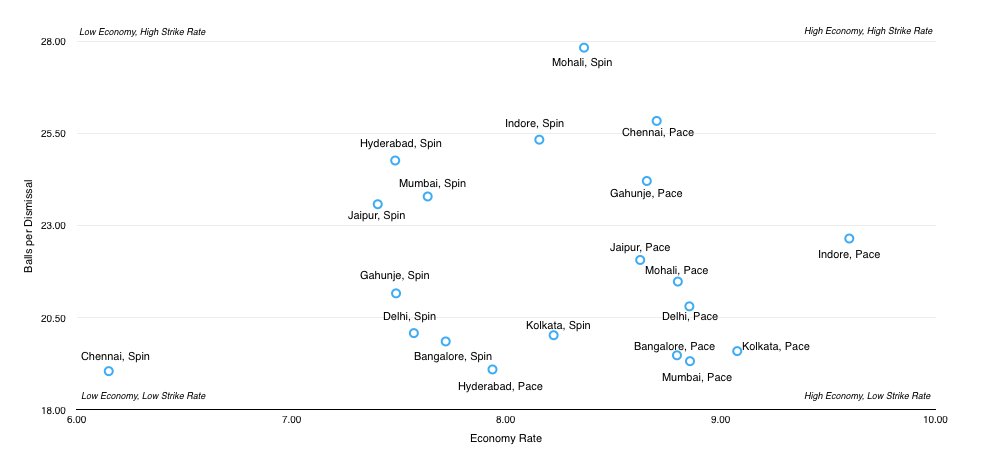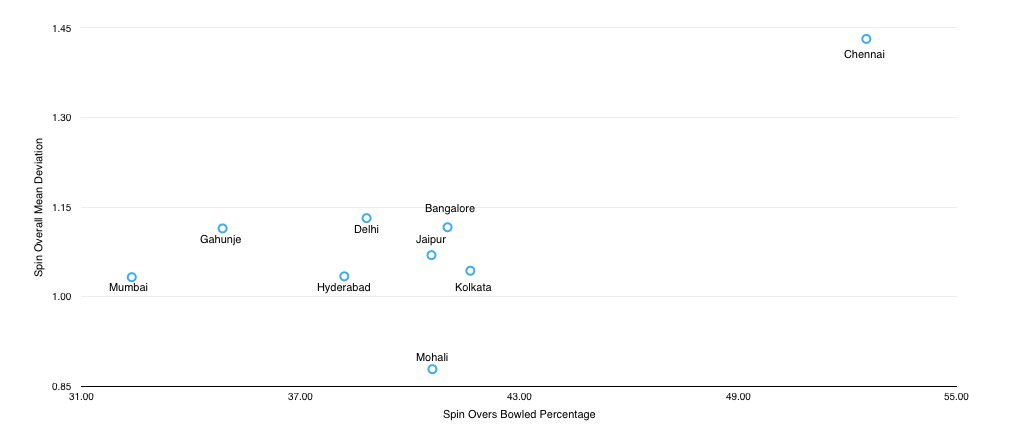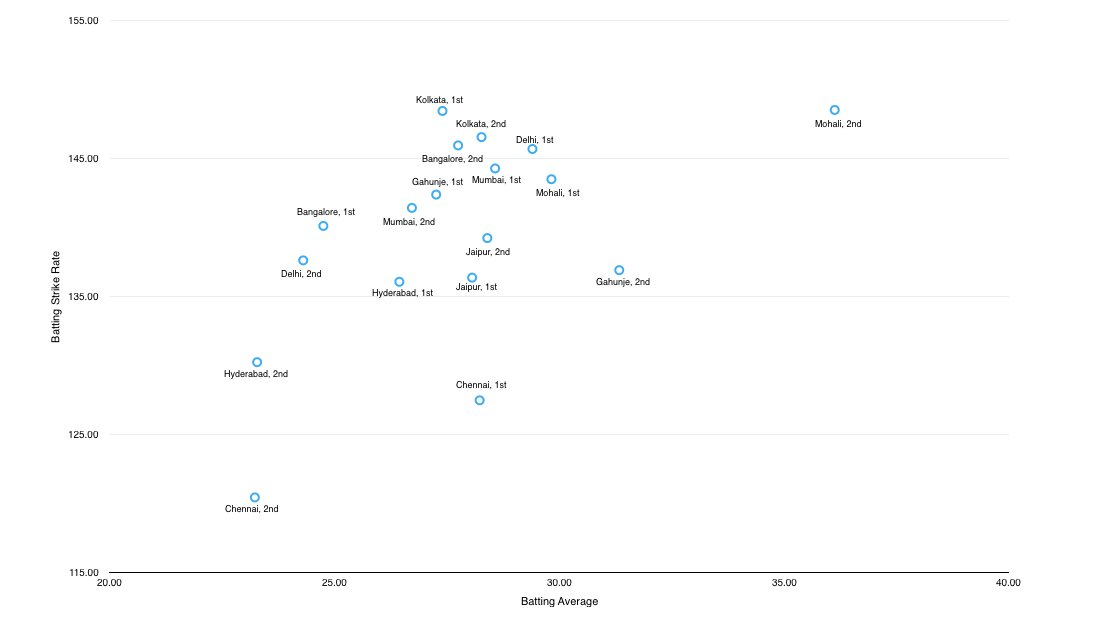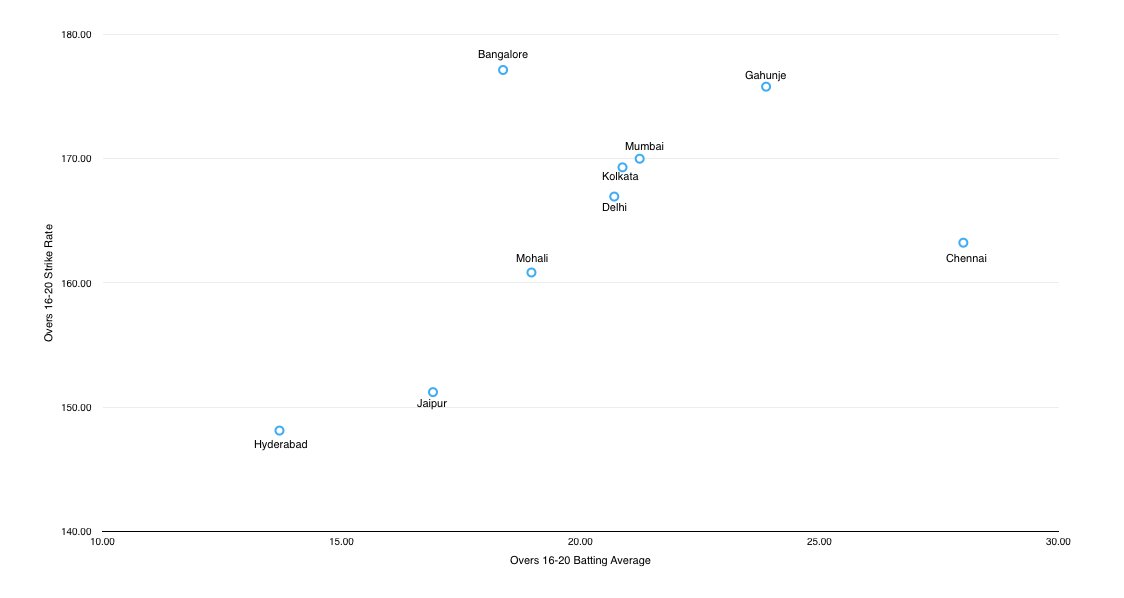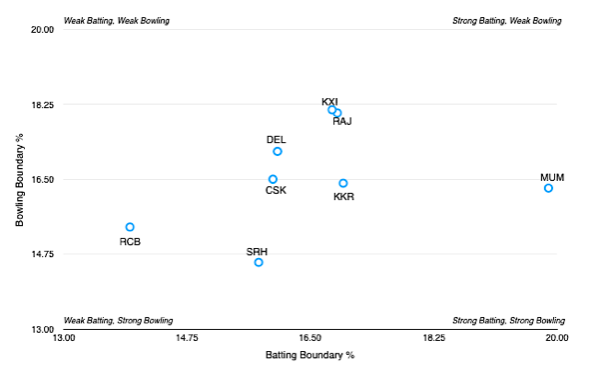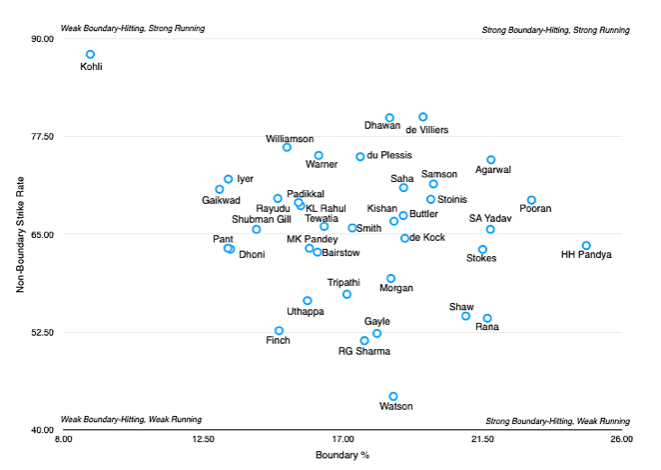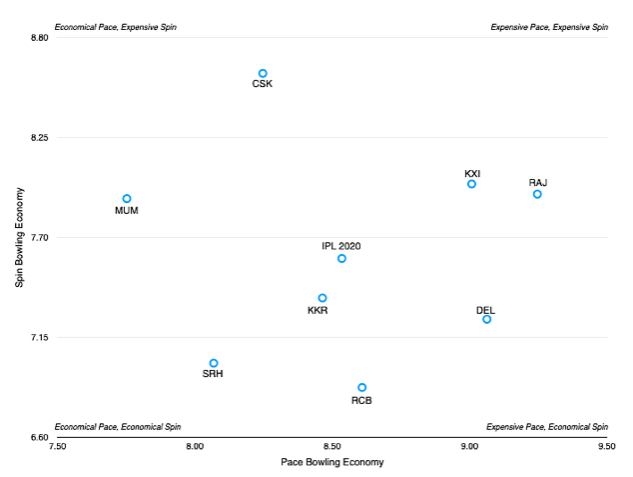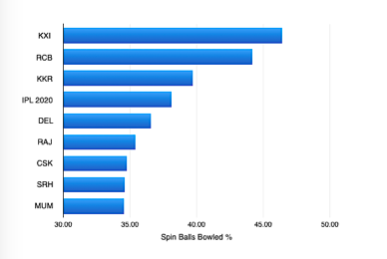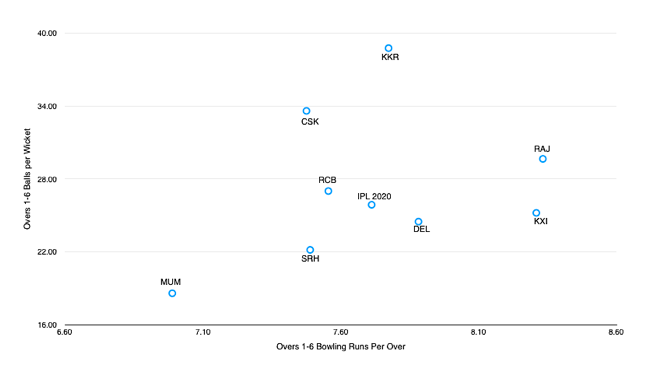Really excited for the start of the IPL today, so I thought I’d create a mega-thread which looks at data of the various venues across the last few years, plus squad performance data from last year as well.
[THREAD]
[THREAD]
Firstly, if you want to hear my thoughts on each squad’s chances, recruitment and selection then you can do so via @thecricketpod who I joined for their podcasts for each team in advance of the tournament.
Here’s their Spotify link: https://open.spotify.com/show/7uddSH8MhaK3Q6YFlllbVZ?si=kcG43D0NTKSM9iBPmZBwUA">https://open.spotify.com/show/7udd...
Here’s their Spotify link: https://open.spotify.com/show/7uddSH8MhaK3Q6YFlllbVZ?si=kcG43D0NTKSM9iBPmZBwUA">https://open.spotify.com/show/7udd...
The venue charts in this thread and far more - over 160 pages of data-driven strategy discussion - are available in my e-book ‘Strategies for Success in the Indian Premier League’ which is available here:
http://www.sportsanalyticsadvantage.com/strategies-for-success-in-the-indian-premier-league-book">https://www.sportsanalyticsadvantage.com/strategie...
http://www.sportsanalyticsadvantage.com/strategies-for-success-in-the-indian-premier-league-book">https://www.sportsanalyticsadvantage.com/strategie...
There might be a better guide to the IPL than my book, but I haven’t seen it yet!
So if you’re interested in a deep dive into the data behind the IPL teams, players and strategies then definitely check it out.
So if you’re interested in a deep dive into the data behind the IPL teams, players and strategies then definitely check it out.
First of all for the strategy discussion this year - venues.
Last year’s rearranged IPL was played at 3 venues in the UAE which weren’t the normal IPL venues.
This year the matches are being played back in India but no ‘home’ venues for teams.
Last year’s rearranged IPL was played at 3 venues in the UAE which weren’t the normal IPL venues.
This year the matches are being played back in India but no ‘home’ venues for teams.
The venues being used this year are as follows:
Chepauk (Chennai)
Mumbai
Motera (Ahmedabad)
Delhi
Bangalore
Kolkata
Chepauk (Chennai)
Mumbai
Motera (Ahmedabad)
Delhi
Bangalore
Kolkata
Understanding the venue dynamics for each ground is key for teams to strategise well - to pick the best starting XI for each match, varying the structure of their teams (particularly the pace/spin balance of their bowling group being just several examples.
This first chart looks at the batting bias of the regular IPL venues between 2017 and 2019 (time scale for all venue charts):-
Kolkata (high boundary %, low NBSR) looks to be the easiest boundary-hitting venue with Mumbai the next closest.
Without knowing ground dimensions these two look potentially smaller venues than most.
Without knowing ground dimensions these two look potentially smaller venues than most.
Conversely, Hyderabad and Jaipur look bigger venues (low boundary %, high NBSR) but they’re not being used this year.
Chennai just looks a bowlers paradise (low boundary % and low NBSR) and simply a very tricky batting venue generally.
Chennai just looks a bowlers paradise (low boundary % and low NBSR) and simply a very tricky batting venue generally.
Here we can see that Chennai has a massive bias towards spin (bottom left corner) compared to pace (top-right) while Delhi and Bangalore also have a little spin bias. Kolkata is high scoring against both bowling types. Pace is a better wicket-taking option at Mumbai.
Understanding the difference between pace and spin economy rates is useful too. Pace will always be more expensive than spin simply due to the phases in which each bowling type is used, but there are varying extents:-
There were several factors as to why CSK arguably overperformed in 2019 (they won a lot of tosses as well in 2019 and 2018 combined) but them understanding the dynamics of their home venue better than their opposition was critical too.
Chennai has the biggest spin bias of all venues & with CSK not playing there this year, it could be a big negative for people hoping that CSK will recover from last year.
Teams playing at Chennai should structure up to have minimum 12 spin overs available from their starting XI.
Teams playing at Chennai should structure up to have minimum 12 spin overs available from their starting XI.
Some of the more pace-friendly venues (Hyderabad, Mohali) aren’t in action this year so we could conceivably see a tournament more dominated by spin than is frequently the case (and almost certainly more than in the UAE last year).
Again via this chart looking at different metrics we can see how Chennai was the most spin-friendly venue by some distance:-
The highest spin overs bowled % was at Chennai, and so was the highest mean deviation (spinners performed best there relative to overall tournament mean figures). Teams must structure up their XIs there accordingly by default until proven otherwise.
Venue toss bias can be quantified to some extent by looking at batting average and strike rate for 1st and 2nd innings at the grounds in between 2017 and 2019 in the IPL:-
Chennai and Delhi look two of the better venues to bat first on, while Kolkata and in particular, Bangalore, look to have more of a benefit to chasing.
I’m not a buyer of the default win toss and chase mantra, although it certainly has its merits at some venues.
I’m not a buyer of the default win toss and chase mantra, although it certainly has its merits at some venues.
Finally for venues, a little phase data. First of all, overs 1-6 (Powerplay) for each venue between 2017 and 2019:-
Chennai and to a lesser extent (and surprisingly considering its high-scoring reputation) Bangalore have poor Powerplay batting data.
If a team is around 45-0 or 45-1 after the Powerplay in Chennai then they’re not in a bad place.
If a team is around 45-0 or 45-1 after the Powerplay in Chennai then they’re not in a bad place.
On the flip side, perhaps influenced by the dynamics of KKR, the Powerplay strike rate of Kolkata is very high, and fairly similarly at Delhi too. Mumbai is more midrange.
Chennai is again low-scoring at the death - again asserting that it’s a difficult batting venue - while Bangalore in particular is the opposite.
Again with Bangalore there is probably some weighting via the ‘strategy’ of the home side (conservative starts, attacking finishes).
Again with Bangalore there is probably some weighting via the ‘strategy’ of the home side (conservative starts, attacking finishes).
Moving on to the teams, a useful indicator of underlying performance levels is the net boundary % (boundary % scored - boundary % conceded), given that around 85% of teams with the highest boundary % win the match
Here we can see that last year, Mumbai had the best figure by some distance - it’s difficult to dispute that they were deserved winners.
Interesting to see Delhi being negative - did they overperform last year? Did RCB also?
Interesting to see Delhi being negative - did they overperform last year? Did RCB also?
The batting/bowling dynamic of each team is also interesting to look at. Only Delhi of the qualifying teams had worse than average boundary concession. Big bowling issues last year for Punjab and Rajasthan - needs to be fixed this year.
PBKS have a chance of doing so, with the addition of Jhye Richardson and hopeful inclusion of Ishan Porel who I think has nice upside. I’m less convinced about RR being able to do so, given the (at least partial) absence of Jofra Archer.
A quick look at team batting output is always interesting, so here’s batting boundary % versus balls per dismissal for each team - champions Mumbai with the best numbers by a long way via these metrics:-
Conversely, RCB, SRH and CSK look like they need to dial up the attacking intent a little more - SRH less so because of their above-average bowling group which should have good role clarity.
For individual batters, here’s a chart which shows the boundary % and non-boundary strike rate for batters facing 150+ balls last season.
You’ll note that Kohli’s boundary percentage was lower than any other player by a long way. He’s an elite rotator/runner between the wickets though, but this lack of boundary intent was a big issue for RCB in my view - moving to opener could help.
The batters towards the top-right corner are the most complete - AB De Villiers is a frequent inclusion in this zone - and I wonder for how long he will be able to keep this level up. If he can, he looks like the best batter in the tournament.
Understanding phase performance is also extremely useful. The chart below assesses Overs 1-6 strike rates and balls per dismissal for each team in the 2020 IPL:-
KKR and CSK in particular struggled with batting in the Powerplay last year and I think KKR need to rip up the Narine pinch-hitting script. If they do continue to go down that road, they need more batting depth (e.g. not Cummins at 7).
CSK just appeared to lack hitting intent and although Moeen Ali should be a big benefit to them in this area, I’m not convinced about much of the rest of their batting group. It could well be a tough season for them.
Moving on to the middle overs, RCB’s lack of boundary intent in this phase is evidenced by their middle over strike rate - again CSK with not enough intent which is traded off with high stability. RCB in particular are making themselves play catchup from this phase.
At the death, Mumbai were by far the best team last year - and it’s not even close.
SRH needed more intent in this phase which was why I advocated a lower-order hitter for their recruitment in the auction. Instead, they got Kedar Jadhav...
SRH needed more intent in this phase which was why I advocated a lower-order hitter for their recruitment in the auction. Instead, they got Kedar Jadhav...
Continuing onto team bowling data, SRH had the best bowling group with economical pace and spin last year. If Bhuvneshwar stays fit, their bowling attack should get them through some lower-scoring clashes.
Again, bowling issues for Punjab & RR...
Again, bowling issues for Punjab & RR...
Punjab also bowled the most spin by a reasonable distance as well, with Mumbai the least.
Given Mumbai have some matches at Chepauk this year, would a lack of spin for them be a factor which could see them struggle a little more?
Given Mumbai have some matches at Chepauk this year, would a lack of spin for them be a factor which could see them struggle a little more?
Looking at how the runs are scored from each bowling group is also useful.
Here we can see that CSK had the worst non-boundary strike rate conceded by some distance - is this a side effect of having the oldest team in the tournament?
Here we can see that CSK had the worst non-boundary strike rate conceded by some distance - is this a side effect of having the oldest team in the tournament?
Mumbai had the best bowling output in the Powerplay last year by a long way, with the bowling struggles of RR and Punjab again illustrated by the overs 1-6 bowling chart here. KKR struggled with wicket-taking.
In the middle overs, Punjab struggled again. Mumbai had a weaker middle overs than many other teams - is this another area where the champions can be targeted? Trying to make them deviate from their preferred role clarity could be an approach.
Conversely, SRH and RCB did pretty well in the middle overs with the ball. No surprise considering SRH have Rashid Khan and the RCB spin bowling group did pretty well as a unit.
Finally for the bowling, RR and PBKS need to markedly improve their death bowling.
I would envisage that this is why RR picked up Morris to bowl with Archer in this phase, but of course this has potentially been scuppered by Archer’s injury.
I would envisage that this is why RR picked up Morris to bowl with Archer in this phase, but of course this has potentially been scuppered by Archer’s injury.
It will be very difficult for teams to qualify with poor death bowling output. PBKS will be hoping that Jhye Richardson helps them in this phase & he should do so.
Mumbai with the best death bowling figures by a long way, with 2nd placed Delhi second - a key driver of success?
Mumbai with the best death bowling figures by a long way, with 2nd placed Delhi second - a key driver of success?
To finish, a little quick discussion on the age dynamic of each team. CSK have the most players aged 34+ by some distance, with Mumbai possessing none. Is the lack of aged players for Mumbai by design? If so, will they not retain Rohit next year?
CSK also spend the most crore on players aged 34+ by some distance. I’m extremely unconvinced that they’re doing it right, and it will be interesting to see whether such an ageing team will perform well this year. I have my doubts.
To finish up, thanks for reading & I hope the thread was useful and informative in advance of the tournament.
Really looking forward to it starting in a few hours time!
Really looking forward to it starting in a few hours time!

 Read on Twitter
Read on Twitter
